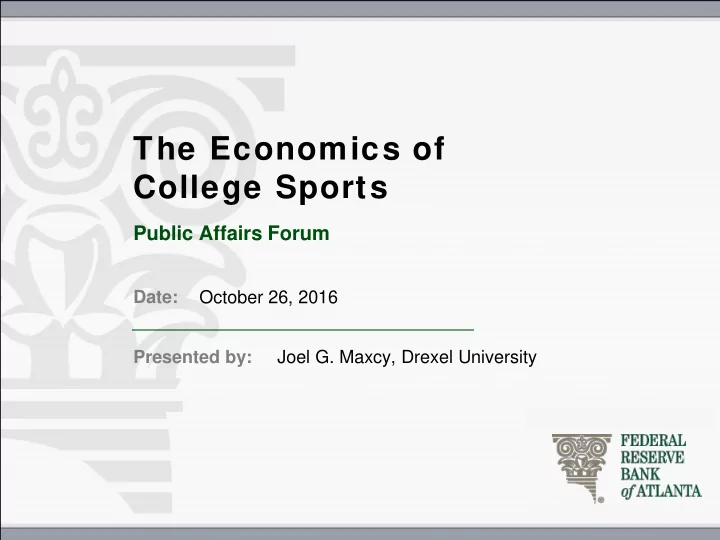

The Economics of College Sports Public Affairs Forum Date: October 26, 2016 Presented by: Joel G. Maxcy, Drexel University
ECONOMICS OF THE PLAYERS’ LABOR MARKET Primary Questions 1. Aren’t intercollegiate sports a fiscal drag on most universities? 2. Won’t pay-for-play exacerbate this problem? 3. If revenue-sports players are paid, won’t most other sports be eliminated? 4. Isn’t the increasing cost of sports a burden for the rest of the student body? 5. Are unions an option? 6. Title IX?
SOME FACTS Big-time college sports have TV and stadium audiences and generate revenues comparable to their professional sports counterparts NCAA Division 1 Football D1 Men’s Basketball Intercollegiate college sports as a commercial endeavor is unique to America The NCAA has 1000+ members 128 are FBS football, 200 more D1 basketball Majority of intercollegiate college sports are little more than participation opportunities for the athletes
WHAT IS THE UNIVERSITY’S OBJECTIVE? Those sponsoring NCAA sports are nonprofit institutions Prestige maximizers and individual units may be revenue maximizers Attract students (customers) but also the best possible students…and faculty… and donations for facilities, the endowment etc. Intercollegiate athletics delivers toward this goal Publicity — Advertising Revenue Amenities
FINANCIAL CONTRIBUTION: FOOTBALL FBS Football Is a Profit Center. Profits are increasing at 6% per year above inflation Based on data from US EADA disclosure. Adjusted for inflation to 2014 prices.
FINANCIAL CONTRIBUTION: BASKETBALL Men’s Major Conference basketball is also profitable Women’s basketball generates significant revenue, but is not profitable Based on data from US EADA disclosure. Adjusted for inflation to 2014 prices.
FINANCIAL INVESTMENT: D1 ATHLETICS FBS Group of Five conferences show the highest levels of investment Power 5 conferences the lowest Based on data from the Chronicle of Higher Education database. Adjusted for inflation to 2014 prices.
FINANCIAL INVESTMENT: D1 ATHLETICS Non-football and lower division football make the largest investments Based on data from the Chronicle of Higher Education database. Adjusted for inflation to 2014 prices.
ROI OF ATHLETIC INVESTMENT TO UNIVERSITY OBJECTIVES 1. Increase in size and depth applicant pool • (Flutie effect) • Academic research is quite consistent on this finding (e.g. Pope & Pope, 2009; Chung, 2013) 2. Increase in gifts • Alumni, others 3. Increased state appropriations 4. Intangible benefits • Community, identity, other feel-good outcomes
CONVERSION TO TANGIBLE SPILLOVER VALUES Anecdotal Examples: 1. Butler: Men’s Final Four runs in 2010 & 2011 Estimated $1 billion in publicity value 2. Alabama: 4 FBS championships since 2009 Nonresident students who pay 2.5 times more tuition have more than doubled from 27% to 63% of incoming students 3. Kansas State: Turnaround from the worst in D1 football to regular bowl participant and contender in the 1990s Enrollment nearly doubled from 12k to 23K, fundraising increased tenfold, says prez. 4. TCU moves to P-5 in 2012 and has become a top FBS championship contender Out of state enrollment increased by 20% in six years
WINNING MAGNIFIES THE BENEFITS Wins are finite, zero sum, and highly valuable The key to winning is talented players College teams compete determinedly for the best talent A market with a rigid price ceiling clearly exists Non-price competition rules the day Persuasive recruiter coaches Lavish facilities
COACHES ARE WELL PAID USA TODAY NCAA COACHES SALARIES 2015 2. $7,087,481 32. $3,305,200 4. $6,875,376 3. $7,004,000 1. $7,299,666
COMPARISON TO PROFESSIONAL SPORTS Coaches’ pay in college football: 3.5% of a team’s revenue. Coaches’ pay in the NFL: 1.5% of team revenues NCAA basketball coaches: 11.2% NBA coaches: 3.2% Salary growth rate 2007 – 12 NCAA football: 9.7% NFL: 4.5%
FACILITIES ARE LAVISH Oregon 2013 $138M Clemson 2016 $55m UGA $30 M 2017
FOOTBALL FACILITY SPENDING UGA Heritage Hall 1987 UGA 2017 $12 million ($25M in 2016) $30 million indoor practice building Tennessee 1988 Tennessee 2013 $10 million ($20M in 2006) $45 million Clemson 2016 $55 million Oregon 2013 $138 million
PURPOSE OF SPENDING IS TO ENTICE THE ATHLETES Wins are of great value More wins serve all elements of university’s objective function Talent is needed to produce wins Wins are finite The competition to lure the best athletes is intense in FBS football and D1 basketball And only in-kind exchanges are permitted
THE PECKING ORDER • Football wins are usually the most valuable… • …the revenue maximizer will invest earnings back into football • For example, 2013 shows a significant increase in P-5 revenues that is immediately followed by major increases in football coaches’ pay • Football and basketball do not pay for other sports • Universities invest because they also have value
SUMMARY College sports are valuable commodities for many universities The NCAA maintenance of the economic cartel brings about the market power advantages in the production of the sports product Monopsony over the (labor) input market is of great redistributional value The most valuable input is underpaid Others collect significant shares Amateurism rules are passé almost everywhere else Yet the NCAA remains unmatched with its deft preservation of this power Collective action is best bet for players As with their professional peers of 50 years ago There are certainly more complications for unions in NCAA sports However it is not inconceivable
Thank you!
Recommend
More recommend